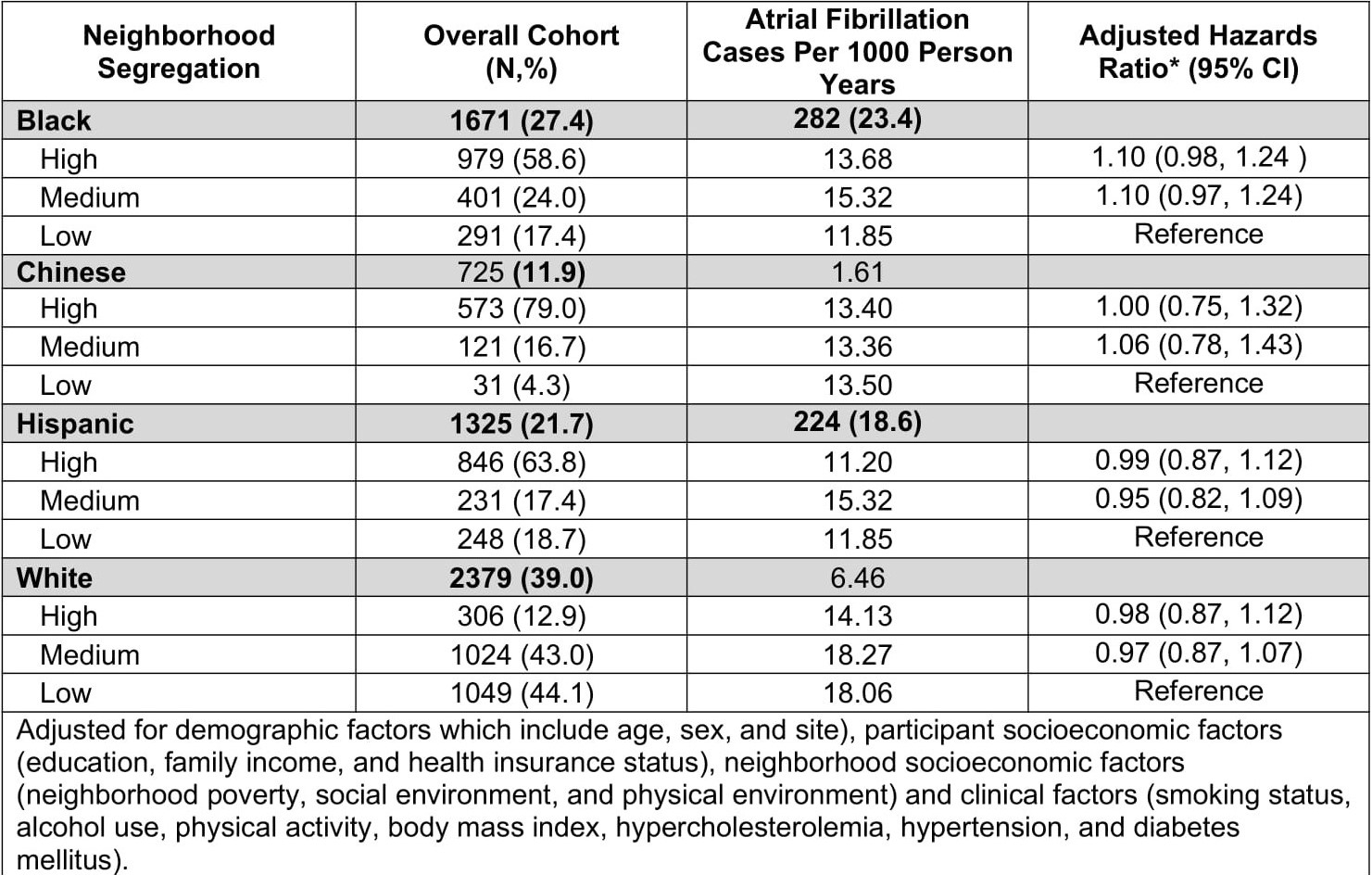Final ID: P2050
Neighborhood-Level Racial and Ethnic Residential Segregation and Incidence of Atrial Fibrillation: The Multi-Ethnic Study of Atherosclerosis (MESA)
Abstract Body: Introduction: Atrial fibrillation (AF) is the most common arrhythmia, affecting up to 6 million in the US, and is associated with significant morbidity and mortality. Despite higher rates of AF clinical and social risk factors, underrepresented racial and ethnic group (UREG) individuals have lower AF incidence. Structural factors, such as neighborhood-level racial/ethnic residential segregation, have been associated with incident cardiometabolic disease, particularly among UREG individuals. However, data on segregation and incident AF is sparse.
Hypothesis: We hypothesized that adults living in more segregated neighborhoods would have a higher incidence of AF.
Goals/Aims: We examined whether AF incidence differed across segregation categories among racial and ethnic groups.
Methods: Administrative and clinical data from the Multi-Ethnic Study of Atherosclerosis (MESA; baseline 2000-2002) were used to identify those with a diagnosis of AF during follow-up. Own-group racial/ethnic segregation was defined by local GI* statistic, which compares the percent of each racial/ethnic group in a current census tract to the surrounding area. Racial/ethnic-stratified Cox proportional hazard models were created to estimate hazard ratios comparing across segregation levels. Models were adjusted for demographic factors, individual and neighborhood level socioeconomic factors, and clinical factors.
Results: Our final cohort comprised 6,100 participants (27% Black, 12% Chinese, 22% Hispanic, 39% White). During a median follow-up of 14.2 years, 1,203 participants (19.7%) were diagnosed with AF. Black and Hispanic participants had the highest prevalence of AF risk factors at baseline. Black, Hispanic, and Chinese participants were more likely to reside in segregated neighborhoods (Table). After adjusting for demographic, socioeconomic and clinical factors, among all racial groups, neighborhood segregation was not associated with incident AF (Table).
Conclusions: In this longitudinal analysis we did not observe a statistically significant association between residential segregation and AF incidence for any racial and ethnic groups in adjusted models. Further research is needed to understand how individual factors may intersect with clinical, healthcare, and structural factors to drive previously described differential incidence of AF.
Hypothesis: We hypothesized that adults living in more segregated neighborhoods would have a higher incidence of AF.
Goals/Aims: We examined whether AF incidence differed across segregation categories among racial and ethnic groups.
Methods: Administrative and clinical data from the Multi-Ethnic Study of Atherosclerosis (MESA; baseline 2000-2002) were used to identify those with a diagnosis of AF during follow-up. Own-group racial/ethnic segregation was defined by local GI* statistic, which compares the percent of each racial/ethnic group in a current census tract to the surrounding area. Racial/ethnic-stratified Cox proportional hazard models were created to estimate hazard ratios comparing across segregation levels. Models were adjusted for demographic factors, individual and neighborhood level socioeconomic factors, and clinical factors.
Results: Our final cohort comprised 6,100 participants (27% Black, 12% Chinese, 22% Hispanic, 39% White). During a median follow-up of 14.2 years, 1,203 participants (19.7%) were diagnosed with AF. Black and Hispanic participants had the highest prevalence of AF risk factors at baseline. Black, Hispanic, and Chinese participants were more likely to reside in segregated neighborhoods (Table). After adjusting for demographic, socioeconomic and clinical factors, among all racial groups, neighborhood segregation was not associated with incident AF (Table).
Conclusions: In this longitudinal analysis we did not observe a statistically significant association between residential segregation and AF incidence for any racial and ethnic groups in adjusted models. Further research is needed to understand how individual factors may intersect with clinical, healthcare, and structural factors to drive previously described differential incidence of AF.
More abstracts on this topic:
12,13-diHOME Attenuates Pro-Arrhythmic Effect of High-Fat Diet
Buck Benjamin, Baer Lisa, Deschenes Isabelle, Chinthalapudi Krishna, Gallego-perez Daniel, Stanford Kristin, Hund Thomas, Areiza Natalia, Xu Xianyao, Elliott Austin, Wan Xiaoping, Nassal Drew, Lane Cemantha, Nirengi Shinsuke, James Natasha Maria
A novel deep learning framework identified associated genes and Interpretable deep learning translation of GWAS findings for drug repurposing in Atrial FibrillationTonegawa-kuji Reina, Xu Jielin, Guntupalli Suman, Barnard John, Chung Mina, Cheng Feixiong

